turn signal BMW 328I SEDAN 2013 User Guide
[x] Cancel search | Manufacturer: BMW, Model Year: 2013, Model line: 328I SEDAN, Model: BMW 328I SEDAN 2013Pages: 248, PDF Size: 5.21 MB
Page 117 of 248

At a glance
Button in the vehicle
Lane departure warning
Camera
The camera is located near the base of the
mirror.
Keep the windshield in the area behind the in‚Äź
terior rear view mirror clean and clear.
Switching on/off Press the button.
‚Ė∑On: the LED lights up.‚Ė∑Off: the LED goes out.
The state is stored for the remote control cur‚Äź
rently in use.
Display in the instrument cluster
‚Ė∑Lines: system is activated.‚Ė∑Arrows: at least one lane marking was de‚Äź
tected and warnings can be issued.
Issued warning
If you leave the lane and if a lane marking has
been detected, the steering wheel begins vi‚Äź
brating.
If the turn signal is set before changing the
lane, a warning is not issued.
End of warning
The warning ends:
‚Ė∑Automatically after approx. 3 seconds.‚Ė∑When returning to your own lane.‚Ė∑When braking hard.‚Ė∑When using the turn signal.
System limits
The system may not be fully functional in the
following situations:
‚Ė∑In heavy fog, rain or snowfall.‚Ė∑In the event of worn, poorly visible, merg‚Äź
ing, diverging, or multiple lane markings
such as in construction areas.‚Ė∑When lane markings are covered in snow,
ice, dirt or water.‚Ė∑In tight curves or on narrow lanes.‚Ė∑When the lane markings are covered by
objects.‚Ė∑When driving very close to the vehicle in
front of you.‚Ė∑When driving toward bright lights.‚Ė∑When the windshield in front of the interior
rearview mirror is fogged over, dirty or cov‚Äź
ered with stickers, etc.‚Ė∑During calibration of the camera immedi‚Äź
ately after vehicle shipment.Seite 113SafetyControls113
Online Edition for Part no. 01 40 2 926 810 - X/13
Page 118 of 248

Active Blind Spot Detection
The concept
Two radar sensors below the rear bumper
monitor the area behind and next to the vehicle
at speeds above approx. 30 mph/50 km/h.
The system indicates whether there are vehi‚Äź
cles in the blind spot, arrow 1, or approaching
from behind on the adjacent lane, arrow 2.
The lamp in the exterior mirror housing lights
up dimly.
Before you change lanes after setting the turn
signal, the system issues a warning in the sit‚Äź
uations described above.
The lamp in the housing of the exterior mirror
flashes and the steering wheel vibrates.
Notes Personal responsibility
The system does not serve as a substi‚Äź
tute for the driver's personal judgment of the
traffic situation.
Be aware of the traffic situation and the vehi‚Äź
cle's surroundings at all times, otherwise an
accident is still possible despite all warnings.‚óÄ
At a glance
Button in the vehicle
Active Blind Spot Detection
Radar sensors
The radar sensors are located under the rear
bumper.
Switching on/off Press the button.
‚Ė∑On: the LED lights up.‚Ė∑Off: the LED goes out.
The system can issue warnings at speeds
above approx. 30 mph/50 km/h.
The state is stored for the remote control cur‚Äź
rently in use.
Seite 114ControlsSafety114
Online Edition for Part no. 01 40 2 926 810 - X/13
Page 119 of 248
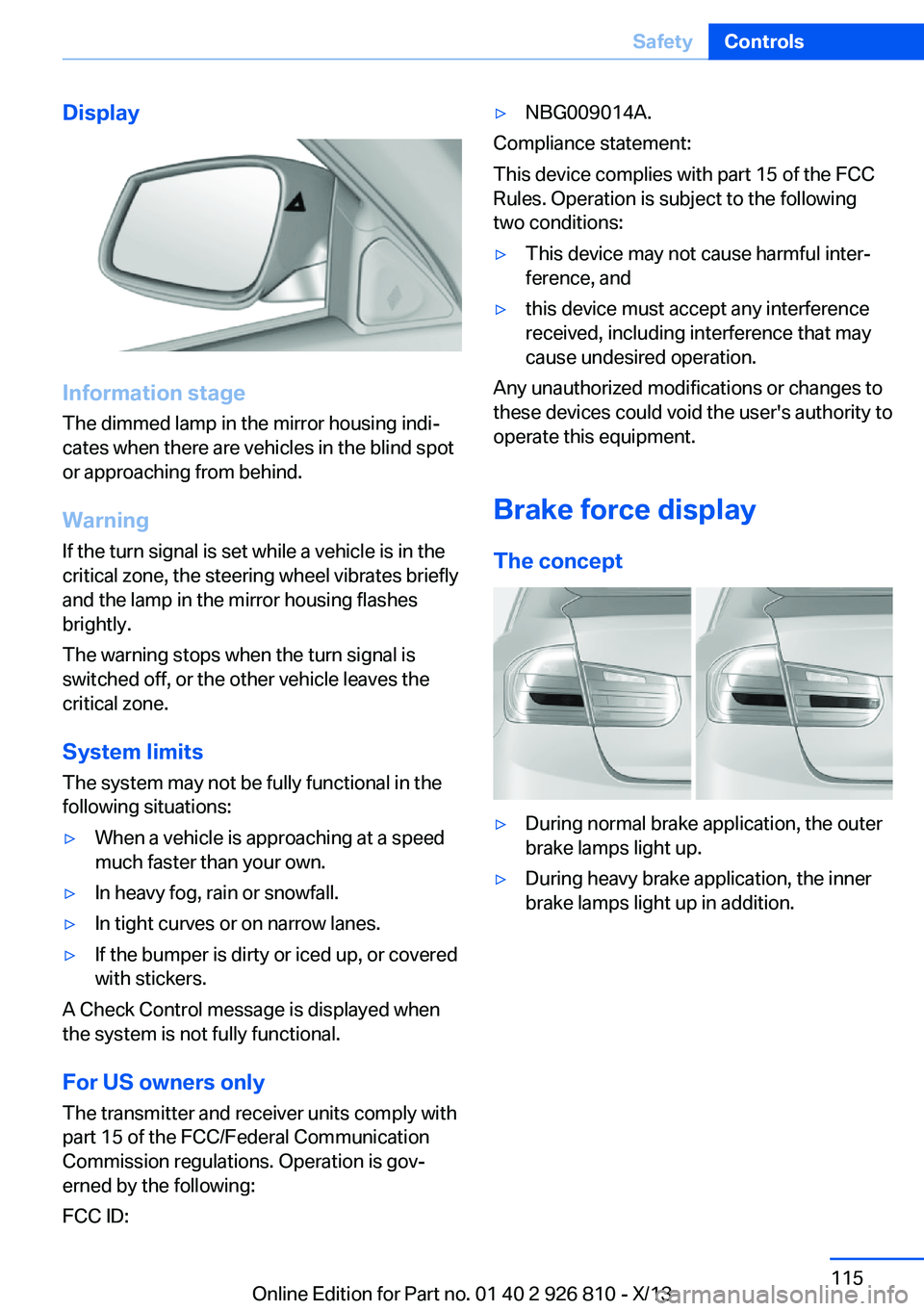
Display
Information stage
The dimmed lamp in the mirror housing indi‚Äź
cates when there are vehicles in the blind spot
or approaching from behind.
Warning
If the turn signal is set while a vehicle is in the
critical zone, the steering wheel vibrates briefly
and the lamp in the mirror housing flashes
brightly.
The warning stops when the turn signal is
switched off, or the other vehicle leaves the
critical zone.
System limits
The system may not be fully functional in the
following situations:
‚Ė∑When a vehicle is approaching at a speed
much faster than your own.‚Ė∑In heavy fog, rain or snowfall.‚Ė∑In tight curves or on narrow lanes.‚Ė∑If the bumper is dirty or iced up, or covered
with stickers.
A Check Control message is displayed when
the system is not fully functional.
For US owners only The transmitter and receiver units comply with
part 15 of the FCC/Federal Communication
Commission regulations. Operation is gov‚Äź
erned by the following:
FCC ID:
‚Ė∑NBG009014A.
Compliance statement:
This device complies with part 15 of the FCC
Rules. Operation is subject to the following
two conditions:
‚Ė∑This device may not cause harmful inter‚Äź
ference, and‚Ė∑this device must accept any interference
received, including interference that may
cause undesired operation.
Any unauthorized modifications or changes to
these devices could void the user's authority to
operate this equipment.
Brake force display
The concept
‚Ė∑During normal brake application, the outer
brake lamps light up.‚Ė∑During heavy brake application, the inner
brake lamps light up in addition.Seite 115SafetyControls115
Online Edition for Part no. 01 40 2 926 810 - X/13
Page 143 of 248

Ultrasound sensors measure parking spaces
on both sides of the vehicle.
The parking assistant calculates the best pos‚Äź
sible parking line and takes control of steering
during the parking procedure.
When parking, also take note of the visual and
acoustic information and instructions issued
by the PDC, the parking assistant and the rear‚Äź
view camera and react accordingly.
A component of the parking assistant is the
PDC Park Distance Control, refer to page 130.
Hints Personal responsibility
Even an active system does not relieve
the driver from personal responsibility for the
driving process.
Because of technical system limits, the system
cannot independently react appropriately in all
traffic situations.
Continuously and attentively monitor the driv‚Äź
ing process, the area surrounding the vehicle
and the traffic situation, and actively intervene
when required, otherwise, there is a risk of an
accident.‚óÄ
Changes to the parking space
Changes to the parking space after it was
measured are not taken into account by the
system.
Therefore, always be alert and ready to inter‚Äź
vene; otherwise, there is the danger of an acci‚Äź
dent occurring.‚óÄ
Transporting loads
Loads that extend beyond the perimeter
of the vehicle are not taken into account by the
system during the parking procedure.
Therefore, always be alert and ready to inter‚Äź
vene; otherwise, there is the danger of an acci‚Äź
dent occurring.‚óÄCurbs
The parking assistant may steer the vehi‚Äź
cle over or onto curbs.
Therefore, always be alert and ready to inter‚Äź
vene; otherwise, the wheels, tires, or the vehi‚Äź
cle may become damaged.‚óÄ
An engine that has been switched off by the
Auto Start Stop function is restarted automati‚Äź
cally when the parking assistant is activated.
Requirements
For measuring parking spaces‚Ė∑Maximum speed while driving forward ap‚Äź
prox. 22 mph/35 km/h.‚Ė∑Maximum distance to row of parked vehi‚Äź
cles: 5 ft/1.5 m.
Suitable parking space
‚Ė∑Gap between two objects with a minimum
length of approx. 5 ft/1.5 m.‚Ė∑Minimum length of the gap: own vehicle's
length plus approx. 4 ft/1.2 m.‚Ė∑Minimum depth: approx. 5 ft/1.5 m.
For parking procedure
‚Ė∑Doors and trunk lid closed.‚Ė∑Parking brake released.‚Ė∑When parking in parking spaces on the
driver's side, the corresponding turn signal
must be set where applicable.Seite 139Driving comfortControls139
Online Edition for Part no. 01 40 2 926 810 - X/13
Page 146 of 248
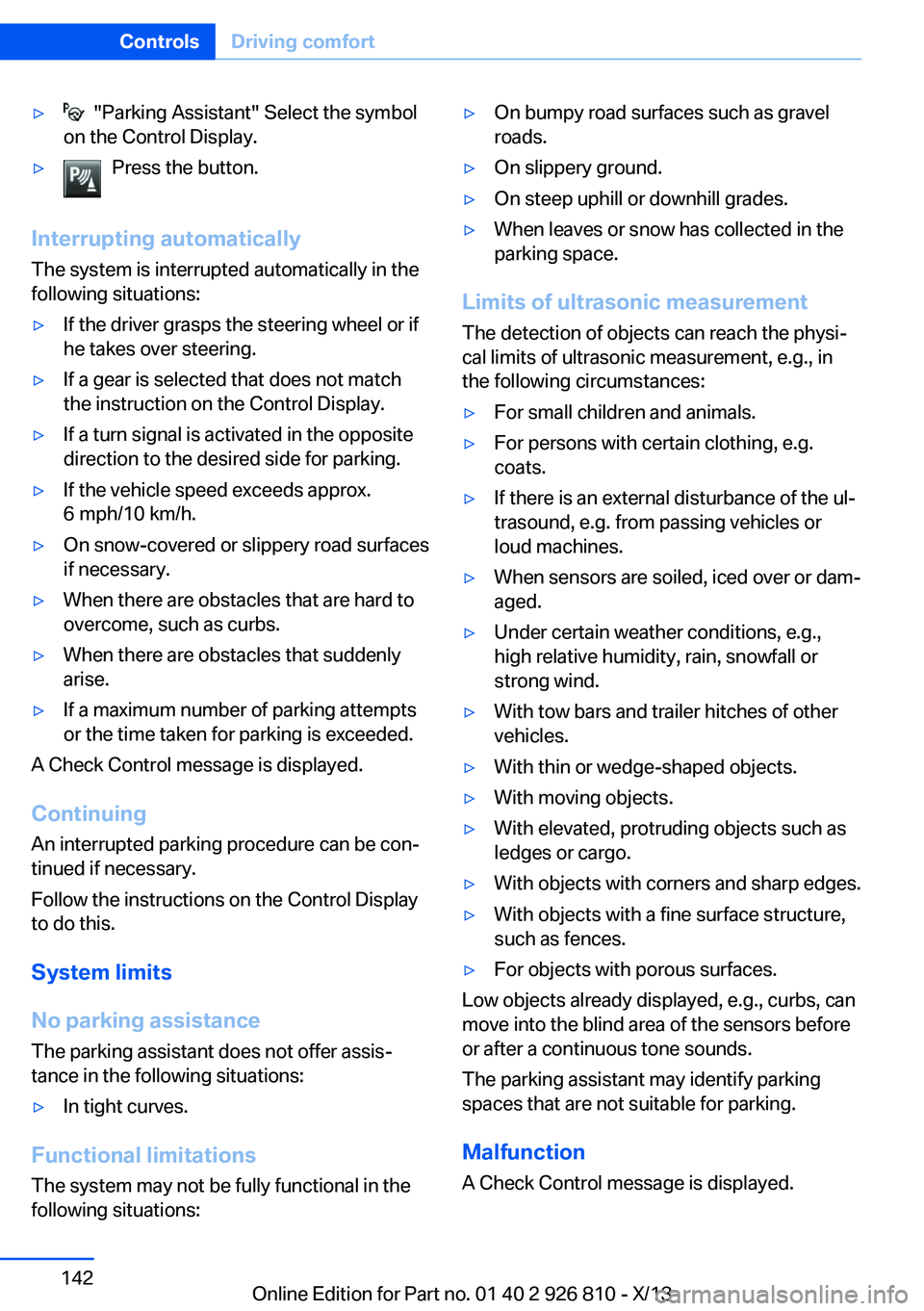
‚Ė∑ "Parking Assistant" Select the symbol
on the Control Display.‚Ė∑Press the button.
Interrupting automatically
The system is interrupted automatically in the
following situations:
‚Ė∑If the driver grasps the steering wheel or if
he takes over steering.‚Ė∑If a gear is selected that does not match
the instruction on the Control Display.‚Ė∑If a turn signal is activated in the opposite
direction to the desired side for parking.‚Ė∑If the vehicle speed exceeds approx.
6 mph/10 km/h.‚Ė∑On snow-covered or slippery road surfaces
if necessary.‚Ė∑When there are obstacles that are hard to
overcome, such as curbs.‚Ė∑When there are obstacles that suddenly
arise.‚Ė∑If a maximum number of parking attempts
or the time taken for parking is exceeded.
A Check Control message is displayed.
Continuing
An interrupted parking procedure can be con‚Äź
tinued if necessary.
Follow the instructions on the Control Display
to do this.
System limits
No parking assistance The parking assistant does not offer assis‚Äź
tance in the following situations:
‚Ė∑In tight curves.
Functional limitations
The system may not be fully functional in the
following situations:
‚Ė∑On bumpy road surfaces such as gravel
roads.‚Ė∑On slippery ground.‚Ė∑On steep uphill or downhill grades.‚Ė∑When leaves or snow has collected in the
parking space.
Limits of ultrasonic measurement
The detection of objects can reach the physi‚Äź
cal limits of ultrasonic measurement, e.g., in
the following circumstances:
‚Ė∑For small children and animals.‚Ė∑For persons with certain clothing, e.g.
coats.‚Ė∑If there is an external disturbance of the ul‚Äź
trasound, e.g. from passing vehicles or
loud machines.‚Ė∑When sensors are soiled, iced over or dam‚Äź
aged.‚Ė∑Under certain weather conditions, e.g.,
high relative humidity, rain, snowfall or
strong wind.‚Ė∑With tow bars and trailer hitches of other
vehicles.‚Ė∑With thin or wedge-shaped objects.‚Ė∑With moving objects.‚Ė∑With elevated, protruding objects such as
ledges or cargo.‚Ė∑With objects with corners and sharp edges.‚Ė∑With objects with a fine surface structure,
such as fences.‚Ė∑For objects with porous surfaces.
Low objects already displayed, e.g., curbs, can
move into the blind area of the sensors before
or after a continuous tone sounds.
The parking assistant may identify parking
spaces that are not suitable for parking.
Malfunction
A Check Control message is displayed.
Seite 142ControlsDriving comfort142
Online Edition for Part no. 01 40 2 926 810 - X/13
Page 211 of 248
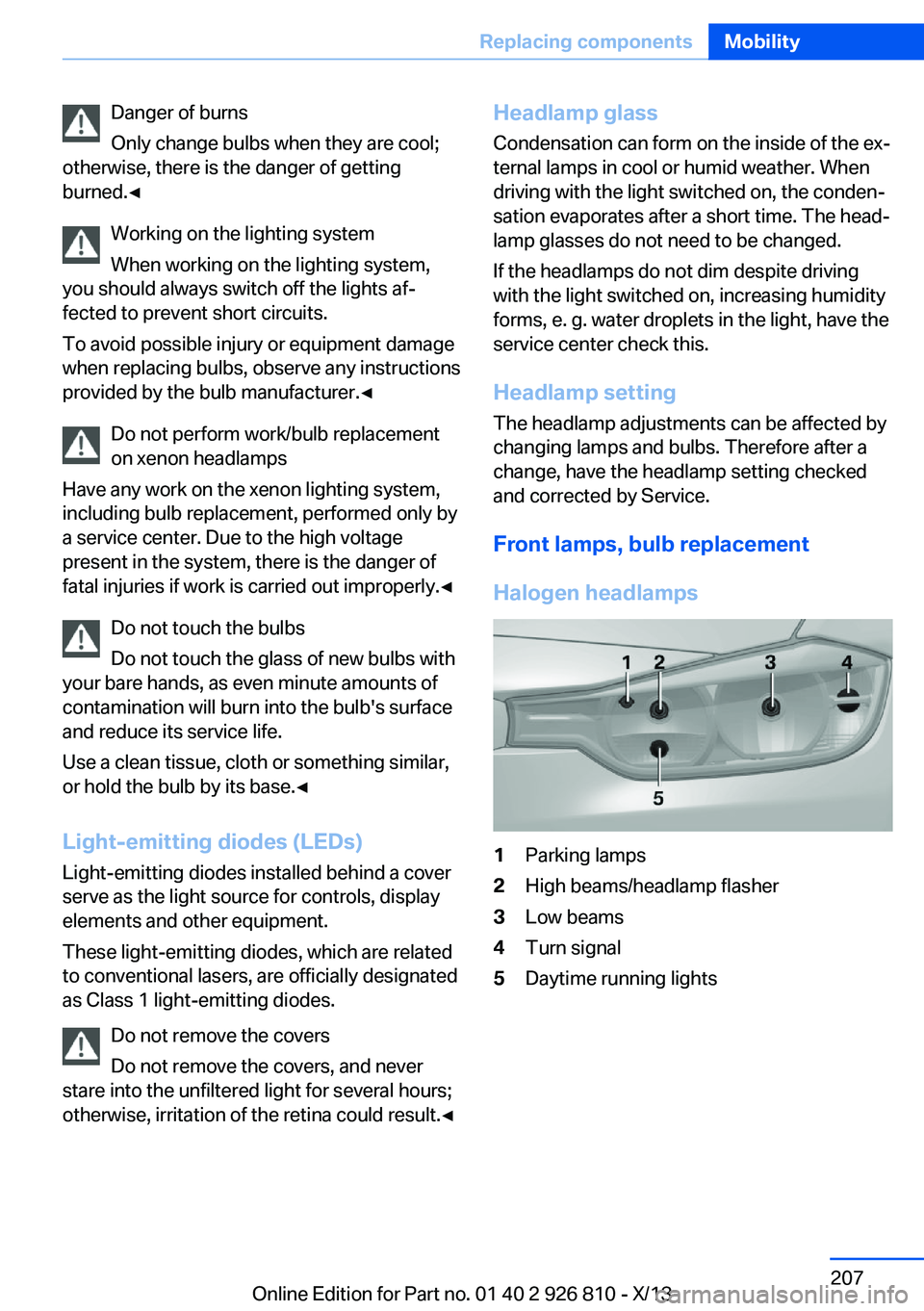
Danger of burns
Only change bulbs when they are cool;
otherwise, there is the danger of getting
burned.‚óÄ
Working on the lighting system
When working on the lighting system,
you should always switch off the lights af‚Äź
fected to prevent short circuits.
To avoid possible injury or equipment damage
when replacing bulbs, observe any instructions
provided by the bulb manufacturer.‚óÄ
Do not perform work/bulb replacement
on xenon headlamps
Have any work on the xenon lighting system,
including bulb replacement, performed only by
a service center. Due to the high voltage
present in the system, there is the danger of
fatal injuries if work is carried out improperly.‚óÄ
Do not touch the bulbs
Do not touch the glass of new bulbs with
your bare hands, as even minute amounts of
contamination will burn into the bulb's surface
and reduce its service life.
Use a clean tissue, cloth or something similar,
or hold the bulb by its base.‚óÄ
Light-emitting diodes (LEDs)
Light-emitting diodes installed behind a cover
serve as the light source for controls, display
elements and other equipment.
These light-emitting diodes, which are related
to conventional lasers, are officially designated as Class 1 light-emitting diodes.
Do not remove the covers
Do not remove the covers, and never
stare into the unfiltered light for several hours; otherwise, irritation of the retina could result.‚óÄHeadlamp glass
Condensation can form on the inside of the ex‚Äź
ternal lamps in cool or humid weather. When
driving with the light switched on, the conden‚Äź
sation evaporates after a short time. The head‚Äź
lamp glasses do not need to be changed.
If the headlamps do not dim despite driving
with the light switched on, increasing humidity
forms, e. g. water droplets in the light, have the
service center check this.
Headlamp setting
The headlamp adjustments can be affected by
changing lamps and bulbs. Therefore after a
change, have the headlamp setting checked
and corrected by Service.
Front lamps, bulb replacement
Halogen headlamps1Parking lamps2High beams/headlamp flasher3Low beams4Turn signal5Daytime running lightsSeite 207Replacing componentsMobility207
Online Edition for Part no. 01 40 2 926 810 - X/13
Page 212 of 248
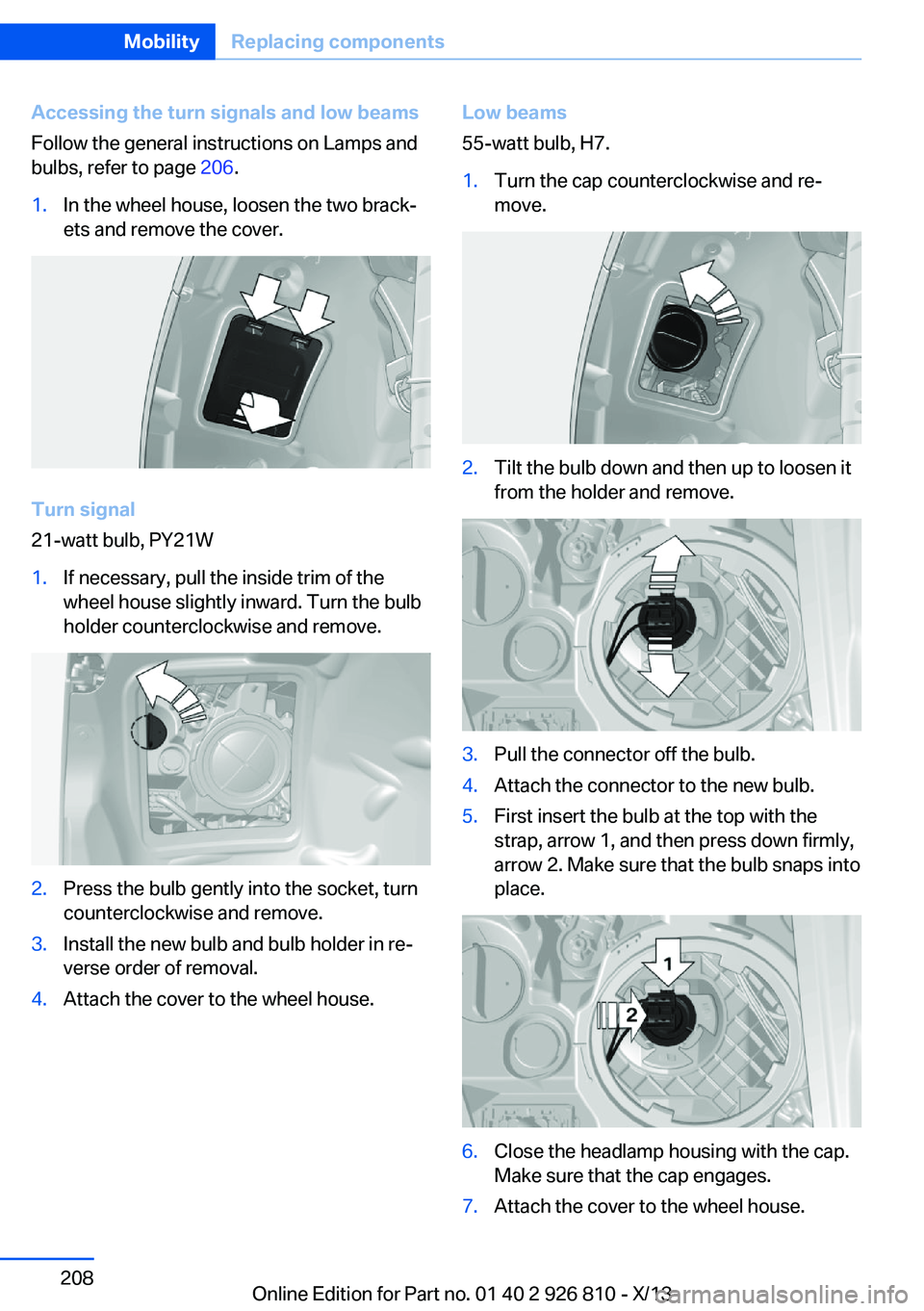
Accessing the turn signals and low beams
Follow the general instructions on Lamps and
bulbs, refer to page 206.1.In the wheel house, loosen the two brack‚Äź
ets and remove the cover.
Turn signal
21-watt bulb, PY21W
1.If necessary, pull the inside trim of the
wheel house slightly inward. Turn the bulb
holder counterclockwise and remove.2.Press the bulb gently into the socket, turn
counterclockwise and remove.3.Install the new bulb and bulb holder in re‚Äź
verse order of removal.4.Attach the cover to the wheel house.Low beams
55-watt bulb, H7.1.Turn the cap counterclockwise and re‚Äź
move.2.Tilt the bulb down and then up to loosen it
from the holder and remove.3.Pull the connector off the bulb.4.Attach the connector to the new bulb.5.First insert the bulb at the top with the
strap, arrow 1, and then press down firmly,
arrow 2. Make sure that the bulb snaps into
place.6.Close the headlamp housing with the cap.
Make sure that the cap engages.7.Attach the cover to the wheel house.Seite 208MobilityReplacing components208
Online Edition for Part no. 01 40 2 926 810 - X/13
Page 214 of 248
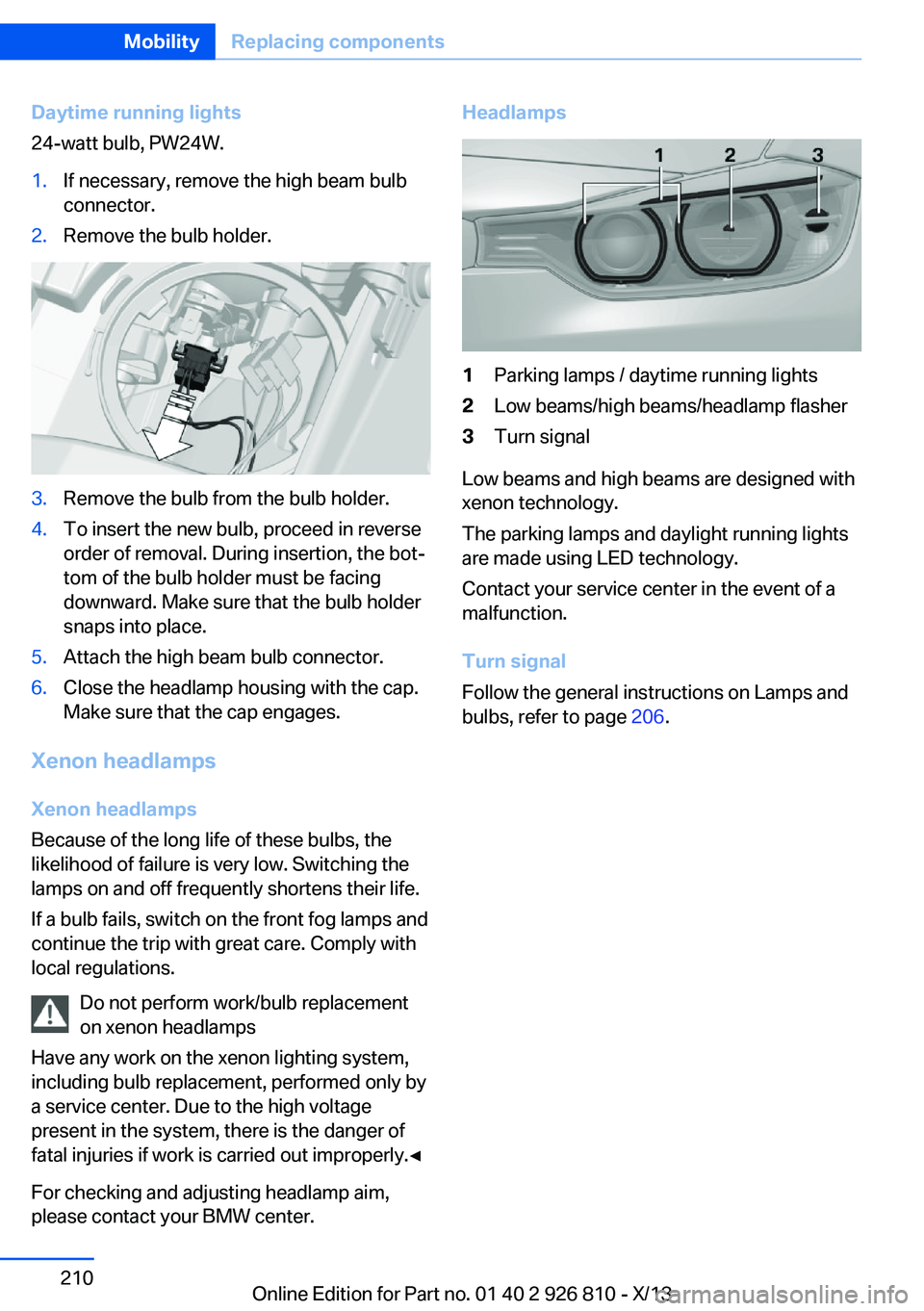
Daytime running lights
24-watt bulb, PW24W.1.If necessary, remove the high beam bulb
connector.2.Remove the bulb holder.3.Remove the bulb from the bulb holder.4.To insert the new bulb, proceed in reverse
order of removal. During insertion, the bot‚Äź
tom of the bulb holder must be facing
downward. Make sure that the bulb holder
snaps into place.5.Attach the high beam bulb connector.6.Close the headlamp housing with the cap.
Make sure that the cap engages.
Xenon headlamps
Xenon headlamps
Because of the long life of these bulbs, the
likelihood of failure is very low. Switching the
lamps on and off frequently shortens their life.
If a bulb fails, switch on the front fog lamps and
continue the trip with great care. Comply with
local regulations.
Do not perform work/bulb replacement
on xenon headlamps
Have any work on the xenon lighting system,
including bulb replacement, performed only by
a service center. Due to the high voltage
present in the system, there is the danger of
fatal injuries if work is carried out improperly.‚óÄ
For checking and adjusting headlamp aim,
please contact your BMW center.
Headlamps1Parking lamps / daytime running lights2Low beams/high beams/headlamp flasher3Turn signal
Low beams and high beams are designed with
xenon technology.
The parking lamps and daylight running lights
are made using LED technology.
Contact your service center in the event of a
malfunction.
Turn signal
Follow the general instructions on Lamps and
bulbs, refer to page 206.
Seite 210MobilityReplacing components210
Online Edition for Part no. 01 40 2 926 810 - X/13
Page 215 of 248

21-watt bulb, PY21W1.In the wheel house, loosen the two brack‚Äź
ets and remove the cover.2.If necessary, pull the inside trim of the
wheel house slightly inward. Turn the bulb
holder counterclockwise and remove.3.Press the bulb gently into the socket, turn
counterclockwise and remove.4.Install the new bulb and bulb holder in re‚Äź
verse order of removal.5.Attach the cover to the wheel house.
Front fog lamps
Follow the general instructions on Lamps and
bulbs, refer to page 206.
35-watt bulb, H8.
1.Use the back side of the screwdriver from
the onboard vehicle tool kit to remove the
three wheel house panel screws, arrow 1.Carefully raise the wheel house panel, ar‚Äź
row 2.2.Pull off the bulb connector, arrow 1.
Turn the bulb, arrow 2.
Left side of vehicle: turn clockwise.
Right side of vehicle: turn counterclock‚Äź
wise.
Remove the bulb.3.Insert the new bulb, connect the connector
and screw on the wheel house panel.
Turn signal in exterior mirror
Follow the general instructions on Lamps and
bulbs, refer to page 206.
The turn signals in the exterior mirrors feature
LED technology. Contact your service center
in the event of a malfunction.
Seite 211Replacing componentsMobility211
Online Edition for Part no. 01 40 2 926 810 - X/13
Page 216 of 248
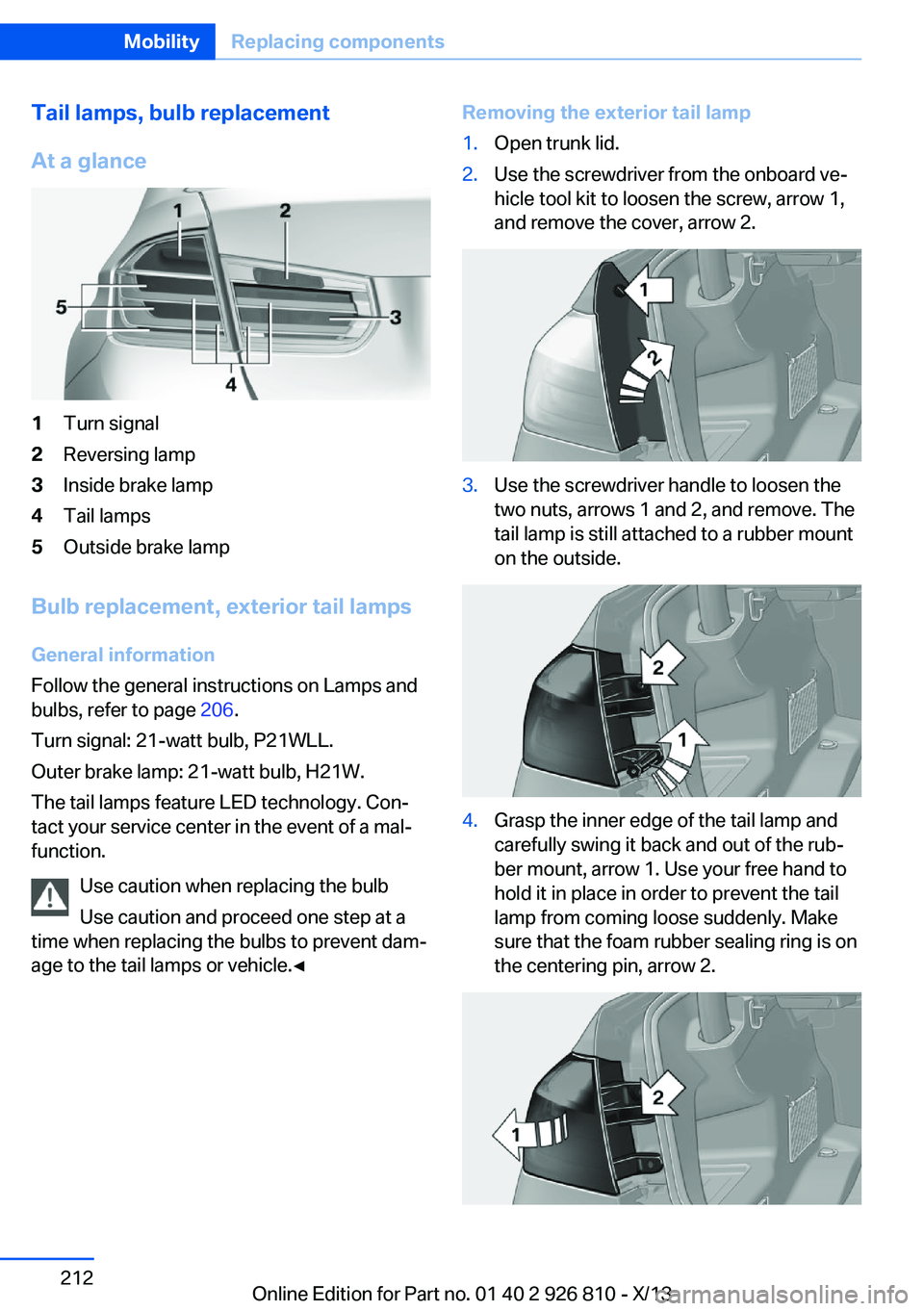
Tail lamps, bulb replacement
At a glance1Turn signal2Reversing lamp3Inside brake lamp4Tail lamps5Outside brake lamp
Bulb replacement, exterior tail lamps General information
Follow the general instructions on Lamps and
bulbs, refer to page 206.
Turn signal: 21-watt bulb, P21WLL.
Outer brake lamp: 21-watt bulb, H21W.
The tail lamps feature LED technology. Con‚Äź
tact your service center in the event of a mal‚Äź
function.
Use caution when replacing the bulb
Use caution and proceed one step at a
time when replacing the bulbs to prevent dam‚Äź
age to the tail lamps or vehicle.‚óÄ
Removing the exterior tail lamp1.Open trunk lid.2.Use the screwdriver from the onboard ve‚Äź
hicle tool kit to loosen the screw, arrow 1,
and remove the cover, arrow 2.3.Use the screwdriver handle to loosen the
two nuts, arrows 1 and 2, and remove. The
tail lamp is still attached to a rubber mount
on the outside.4.Grasp the inner edge of the tail lamp and
carefully swing it back and out of the rub‚Äź
ber mount, arrow 1. Use your free hand to
hold it in place in order to prevent the tail
lamp from coming loose suddenly. Make
sure that the foam rubber sealing ring is on
the centering pin, arrow 2.Seite 212MobilityReplacing components212
Online Edition for Part no. 01 40 2 926 810 - X/13